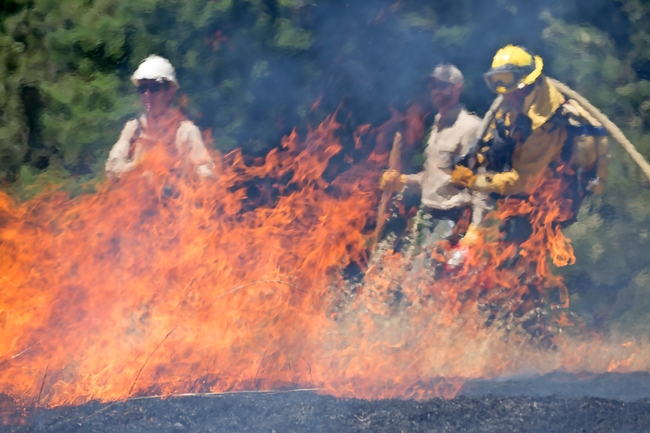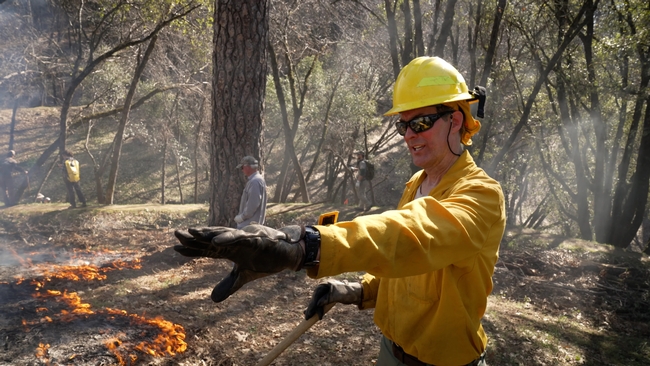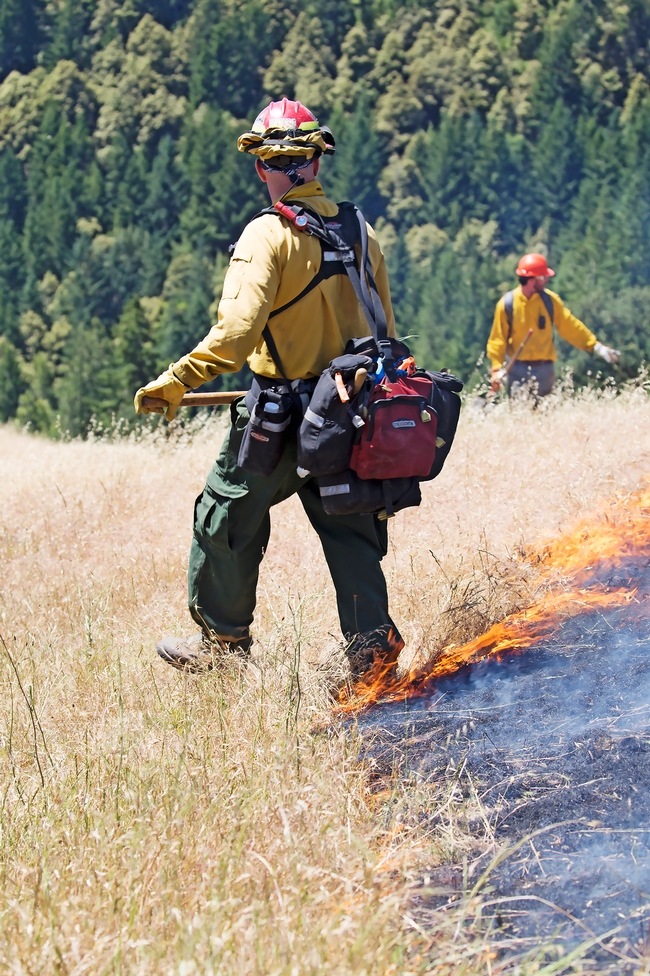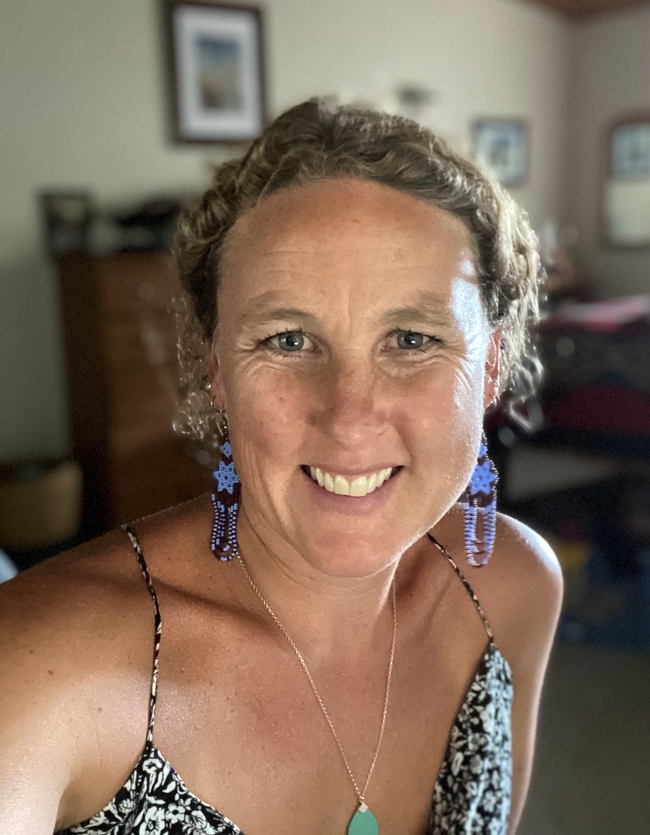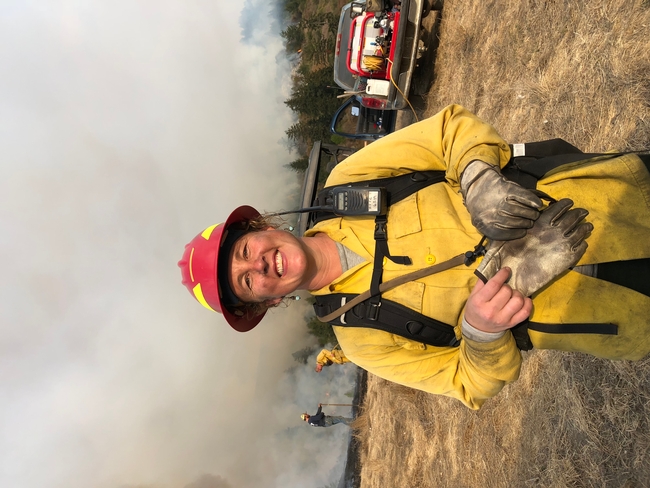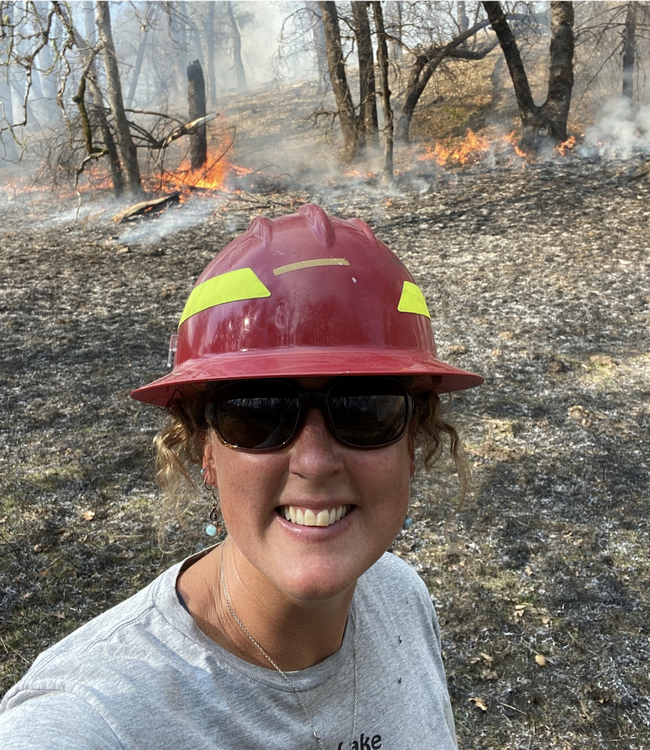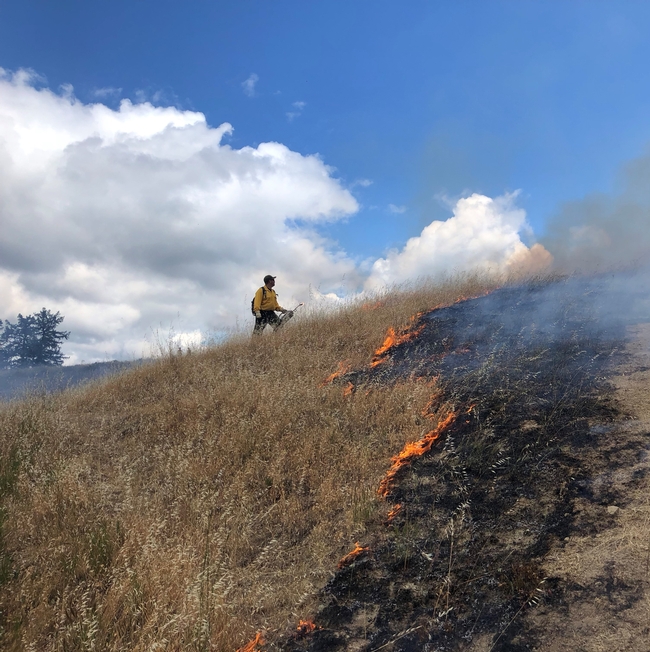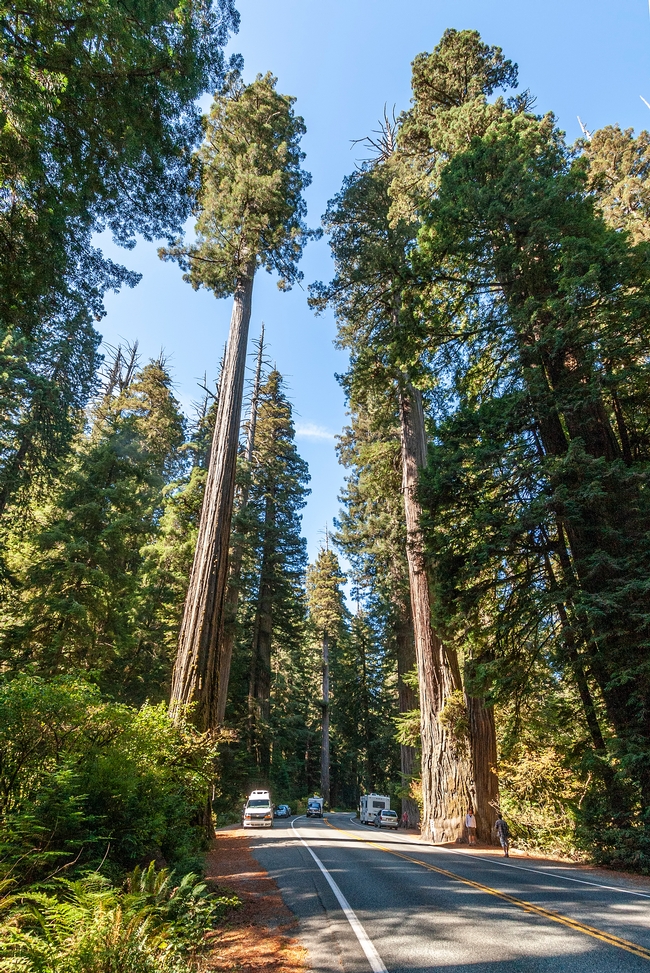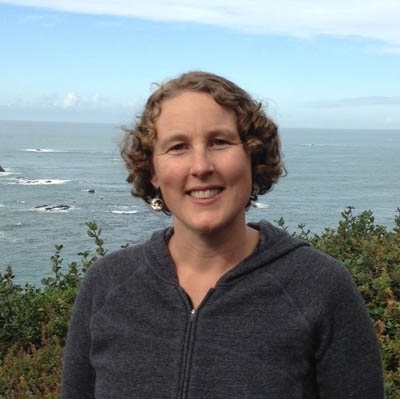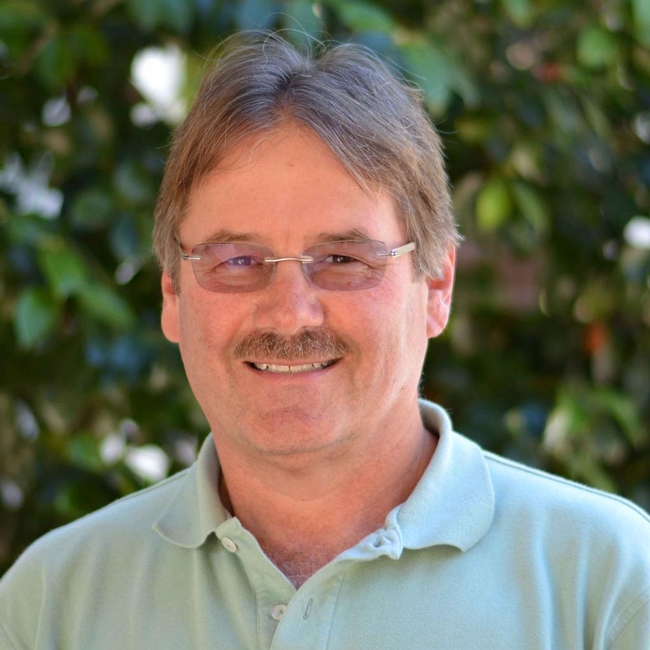Posts Tagged: Lenya Quinn-Davidson
Reforms needed to expand prescribed burns
Study highlights 4 strategies to overcome barriers to prescribed fire in the West
Prescribed fire, which mimics natural fire regimes, can help improve forest health and reduce the likelihood of catastrophic wildfire. But this management tool is underused in the fire-prone U.S. West and Baja California, Mexico, due to several barriers.
A paper from the University of California, Davis, pinpoints those obstacles and suggests four key strategies that policymakers and land managers can take to get more “good fire” on the ground in North America's fire-adapted ecosystems. The paper also provides examples of how people are surmounting some of these obstacles.
“Prescribed fire is one of the most important tools we have for restoring natural fire regimes and undoing the effects of a century of fire suppression,” said lead author John Williams, a project scientist with the UC Davis Department of Environmental Science and Policy. “But there are a number top-down barriers at the upper levels of management that keep us from growing the workforce and getting burns done at the scale and extent needed. We point out some of the big ways that agency leaders and policymakers can dismantle those barriers and empower the full range of people capable of doing this work, from burn bosses and citizen-prescribed burn associations to nonprofits and tribal groups.”
The paper, published in the journal Frontiers in Ecology and the Environment, centers on the North American Mediterranean climate zone, which includes most of California, southwestern Oregon, western Nevada and northern Baja California in Mexico. Lenya Quinn-Davidson, director of UC Agriculture and Natural Resources' Fire Network, is a co-author of the paper.
A natural process
Fire is a natural process that has helped shape this region, but the area has experienced a spike in destructive, high-severity wildfires over the past decade. In fact, three of the five largest wildfires in continental U.S. history occurred in this region in just the past five years. This is due to a combination of climate change and fuel accumulation driven by a century of policies that encouraged fire suppression, curtailed Indigenous cultural burning, and favored harvest of the largest, most fire-tolerant trees, the study notes.
While scientists and resource managers recognize the need for more prescribed fire, its application has not kept pace with the enormity of the challenge. The study said that is because management policies prioritize fire suppression over prevention. There is also a limited fire workforce; regulatory hurdles like permitting, insurance and liability; and few incentives or protections for landowners, tribal members and other people who burn responsibly.
4 key strategies
Researchers identified four key areas where supportive institutional and agency leadership can help expand prescribed fire in the region:
1) Fire culture. After decades of emphasizing wildfire suppression, current fire management culture “does not adequately promote prescribed fire as a management tool,” the study said. Support for prescribed fire along the entire chain of command within agencies is needed to foster a new culture that incentivizes and enables prescribed fire practitioners within and outside of government agencies.
2) Funding. Prescribed fire is considerably more cost-effective than wildfire suppression, which can cost more than $2 billion a year in the U.S., but there is little dedicated funding for prescribed fire projects and lack of flexibility as to when such money can be spent. This impedes fire staffing and limits the kinds of projects that can be done. Year-round, dedicated funding and resources could help increase prescribed fire capacity.
3) Capacity building and cooperation. Connecting agencies with landowners, community members, tribes, prescribed burning associations (PBAs), prescribed fire training exchanges (TREXs) and others can facilitate responsible, effective prescribed fire and cultural burning exchanges. Such groups have limited reach and require investment and support to meet demand.
Inter-organizational agreements can also help local, state and federal agencies share resources and staffing. Formalizing and fully integrating such agreements into fire management plans remains a challenge, the study said. Collaborations that support Indigenous cultural burning are also key.
Partnerships must recognize the unique dimensions of cultural burning, which are inseparable from Indigenous culture. Educating land managers and decision makers about tribal sovereignty and federal American Indian law is critical. Introducing legislation that supports cultural burning can also foster such collaborations.
4) Monitoring and adaptive management. Designated funding and personnel for quantitative monitoring after a prescribed burn can help practitioners better measure success and then apply lessons to future burns.
“All of the barriers identified in the study can be overcome, and they have been at least partially resolved in other parts of the U.S., as well as in other Mediterranean climate regions, such as southwestern Australia,” said co-author Hugh Safford, a research ecologist in the UC Davis Department of Environmental Science and Policy and director of the California Prescribed Fire Monitoring Program. “Fundamental to setting the situation right is developing a culture of safe and regular fire use in California and neighboring states by all landowners and managers, and reducing the officiousness, risk aversion and bureaucracy that hinders access to the tool by the public.”
Additional co-authors include Ashley Grupenhoff and Beth Rose Middleton of UC Davis; Joe Restaino of CAL FIRE; Edward Smith of The Nature Conservancy; Chris Adlam of Oregon State University; and Hiram Rivera-Huerta of Autonomous University of Baja California, Mexico.
This research received financial support from the California Department of Forestry and Fire Protection (CAL FIRE).
This story was originally published on the UC Davis News site.
Quinn-Davidson to lead UC ANR Fire Network
Lenya Quinn-Davidson has been named director of the University of California Agriculture and Natural Resources' Fire Network, effective April 1. UC ANR's statewide Fire Network will build connections and capacity among UC ANR scientists, practitioners, land management and regulatory agencies, policymakers and communities to work toward fire resilience in California.
Wildfire has become more frequent and intense in California with climate change. To meet the challenge of wildfire, UC ANR has hired several new UC Cooperative Extension fire advisors and staff to study issues related to wildfire and to assist Californians with their preparations. Quinn-Davidson and the Fire Network will provide critical coordination and connection across geographies and disciplines ranging from forestry to food safety to livestock to water quality.
“Lenya has more than a decade of work in fire science and has carried out her work through partnerships and community engagement,” said Glenda Humiston, UC vice president of agriculture and natural resources. “Her experience and successful track record will enhance how we coordinate our many layers of research and education related to fire prevention, recovery, public policy and workforce development.”
Quinn-Davidson has served as a UC Cooperative Extension fire advisor for the North Coast since 2016. During her three-year term as the Fire Network director, she will continue her research program and continue to build capacity among landowners, tribes and other communities to use prescribed fire throughout the state. Quinn-Davidson also leads the national/international WTREX program, focused on empowering women and other underrepresented people who work in fire.
“I'm honored to take on this new role, and I can't wait to further grow, connect and support our fire efforts within UC ANR,” Quinn-Davidson said.
UC ANR's Fire Network will also enhance communication.
“The network will increase the flow of information to improve how we conduct academic research, strengthen local efforts by sharing relevant data and ideas, create and build capacity for different management techniques and tools, and facilitate new research and programming related to diverse facets of fire in California,” said Deanne Meyer, UC ANR interim associate vice president.
Before becoming a UCCE fire advisor, Quinn-Davidson worked on fire projects for five years as a UCCE staff research associate. Since 2009, she has served as director of the Northern California Prescribed Fire Council. Prior to joining UC Cooperative Extension, she was a research assistant in the Wildland Fire Laboratory at California State Polytechnic University, Humboldt and worked on stream restoration for Bioengineering Associates, Inc.
She earned a master's degree in social science, environment & community from Cal Poly Humboldt and a bachelor's degree in conservation and resource studies from UC Berkeley.
Quinn-Davidson, who has published more than 70 peer-reviewed and popular articles, will be based in Humboldt County. Follow her on Twitter @lenyaqd.
First-ever California burn boss class meets in Eureka
New certification program will increase opportunities for prescribed fire across California
A group of 19 experienced prescribed burners are gathered in Eureka this week to become certified as prescribed fire burn bosses. The group is the first cohort to participate in the California State-Certified Burn Boss course, part of a certification program that was mandated by legislation in 2018, but was only recently finalized and approved. The course, hosted in Eureka by University of California Cooperative Extension, is a full week session and includes topics from laws, regulations, and permits to burn planning and smoke management.
"With each catastrophic wildfire season in California, the importance of prescribed fire becomes more clear," said Lenya Quinn-Davidson, University of California Cooperative Extension fire advisor, who is hosting the class in Eureka. "Prescribed fire is one of the most ecologically appropriate and cost-effective tools available, and provides innumerable benefits in California's fire-adapted landscapes. Prescribed burning is used to reduce fuels and wildfire risk, but also to restore habitat, control invasive species, improve rangelands, and promote cultural resources and values."
California is remarkably behind when it comes to implementing prescribed fire, she said. While states like Florida burn up to 2 million acres a year, California typically burns less than 100,000 acres statewide. It's clear that fire agencies can't meet the need for this work on their own — collaboration with local communities and leaders is essential.
The new program will certify prescribed fire practitioners who don't work for a fire management agency but are leading prescribed burning in their communities. This week's inaugural class in Eureka includes retired federally qualified burn bosses, tribal burn bosses, and leaders from state and local agencies and nonprofit organizations. Once certified by the state, these burn bosses will be able to share liability with CAL FIRE on prescribed burns.
“We've needed something like this in California for a long time, but never thought we'd see it happen. This is a historic moment for prescribed fire in California,” said Quinn-Davidson, who also leads the Northern California Prescribed Fire Council, and is currently being consulted for legislation that would break down even more barriers to prescribed fire.
In the last several years, more than a dozen community-based prescribed burn associations have developed throughout California. Many of these groups were inspired by the Humboldt County Prescribed Burn Association, which was the first of its kind in the western U.S. when it formed in 2018.
When these newly certified burn bosses leave Eureka, they will be able to go home and lift up efforts on their local landscapes, contributing to fire resilience across the state.
Forest management can help giant sequoias and coastal redwoods survive
In 2020, 9,000 fires scorched more than 4 million acres of California, a record-breaking year, reported Alejandra Borunda in National Geographic. Fires burned through homes and oak forests, grasslands and pines — and also through patches of giant sequoias and coast redwoods, respectively the most massive and the tallest trees on earth.
Giant sequoias are not the oldest living trees, but some have been growing in Sierra Nevada forests for more than 3,200 years. They are found in 68 groves on the Sierra's western flank. The state's redwood forests grow in a narrow strip along the coast of Northern California and Southern Oregon.
The 2020 fires burned through about 16,000 acres of sequoia groves, about a third of their total area. In redwood forests of the Santa Cruz Mountains, 40,000 acres burned.
But because redwoods are well-adapted to fire, they'll likely recover pretty quickly, said Scott Stephens, a UC Berkeley fire scientist. “In some ways, this fire could make redwoods more dominant in the landscape," he said, because other trees — like the hardwoods or Douglas firs that crowded the local forests — died outright in the burns.
However, scientists are concerned one cause of the fires, climate change, could have additional impacts on these natural treasures.
Since the mid-1800s, temperatures in the western U.S. have increased by 1.6 degrees Fahrenheit. Fog banks are fading in coast redwood territory, and snows are less consistent in the Sierras. The changes leave redwoods and sequoias without their preferred climate conditions.
The most responsible thing to do now, Stephens said, is to “take the opportunity that has been handed to us,” and make a plan to go back in and burn again—soon, within the next few years.
UC Cooperative Extension forestry advisor Lenya Quinn-Davidson agrees that California must manage fire to help the trees survive. Tree-ring records show that humans have influenced the fire regime for better and worse as long as they've been in these forests.
“The empowering message there is, human management can actually override the effects of climate in a fire contest,” Quinn-Davidson said. “It's not just a climate story. We can't just throw in the towel, feel overwhelmed, and tell ourselves these trees are done for. That's not true!”
North Coast forests are more dense and dry, fueling fires
Five of California's six largest fires have occurred in 2020, reported Julie Cart in CalMatters.
“There is a collective sensation that we are reaching a tipping point,” said Lenya Quinn-Davidson, a fire specialist with the University of California Cooperative Extension. “This year was not just the fluke burning horrifically. This is 3.2 million acres of fire that burned in a month.”
Quinn-Davidson is based in Humboldt County, with typically rainy, foggy redwood forests. However, she said, the forests don't resemble their former state.
"They are suffering from the same things that the rest of the state forests are. They are poorly managed and have fuels buildup," Quinn-Davidson said.
Redwood and pine forests are many times more dense than at any time in their history.
"We are now entering a new regime, the climate is changing and we are seeing drier conditions and we are seeing a longer fire season. We are not getting that fall precipitation," she said.
The state's 2018 Fourth Climate Assessment included dire predictions for the North Coast: “Future wildfire projections suggest a longer fire season, an increase in wildfire frequency, and an expansion of the area susceptible to fire.”
Average annual maximum temperatures in Mendocino, Humboldt, Del Norte, Lake, Trinity and Siskiyou Counties could increase by as much as 9 degrees through the end of the century, the report concluded.
“The weather and climate is impacting these areas. Last year we were at 60% of average precipitation. We're drier than normal,” said Scott Stephens, a fire scientist at UC Berkeley. “So when lighting strikes, you get an overwhelming number of ignitions in fuels that have been preconditioned to burn.”
The fog that reliably blankets the North Coast is dissipating. Research from UC Berkeley found that fog frequency has declined by a third compared with a century ago.
“Even here in Humboldt County — we are right on the ocean, basically in a rainforest — people are starting to look around and say, ‘Is my house ready for a wildfire?' I'm hearing those conversations,” Quinn-Davidson said.

